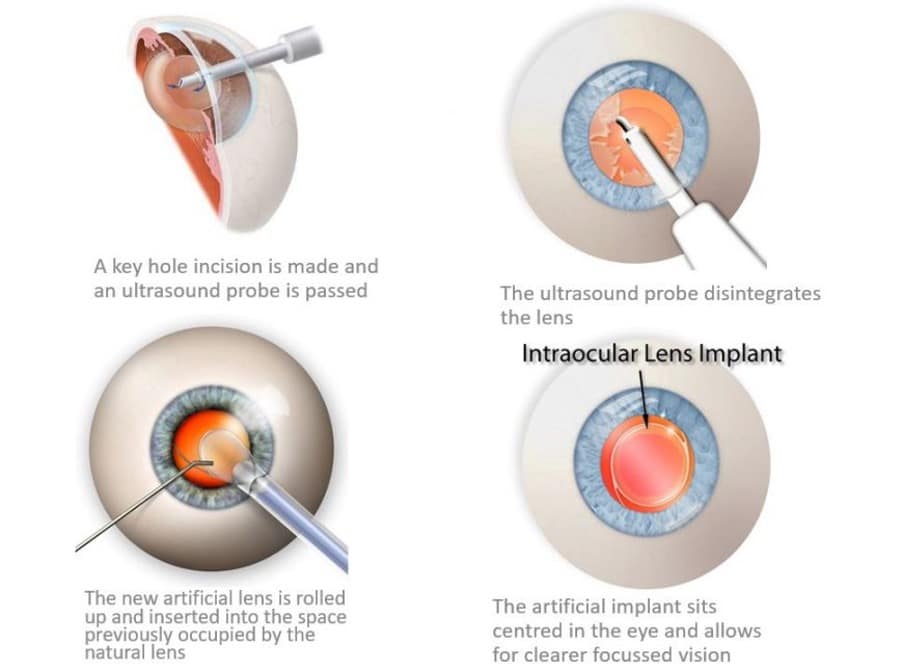Presbyopia affects about 1.8 billion people worldwide. You might know the struggles with varifocal contact lenses if you’re one of them. Vision problems usually start between ages 40 and 50. Your ability to focus on objects at different distances gradually becomes harder.
Multifocal contacts or varifocal daily contact lenses seem like the obvious first choice for most people. These options don’t work well for everyone though. Lens replacement surgery, also called refractive lens exchange, could be worth thinking over if you’re tired of constant adjustments or feel uncomfortable with contacts. This permanent solution has helped countless patients break free from contact lenses’ limitations.
This piece will show you how lens replacement surgery works and what sets it apart from varifocal contacts. You’ll understand what happens during the procedure. On top of that, you’ll see why advanced technology and personalised care make this treatment a popular choice for people who want long-term vision correction.

Struggling with varifocal lenses: signs it’s time for a change
People who wear varifocal contact lenses often get used to compromises in their vision as time goes by. These vision challenges don’t have to be a normal part of your life. The first step to finding better options is knowing when your current lenses aren’t working well enough.
Blurry vision at certain distances
Varifocal contacts promise smooth vision at every distance, but reality tells a different story. You might see persistent blur zones when your eyes move between near and far objects. This happens because these lenses split your vision into zones, which eye doctors call “visual gaps.”
These gaps usually show up when you:
- Look at things at middle distances (computer screens)
- Switch quickly between reading and looking far away
- Try to focus in dim lighting
Your vision quality also tends to get worse as the day goes on because lenses dry out and move around. These vision problems can substantially affect your daily life and overall comfort.
Neck strain from adjusting focus
Have you noticed yourself moving your head in strange ways to find the clearest view? Many varifocal users do this without realising it. Your brain tries to find the best possible vision, which leads to these unconscious head movements. These small adjustments can cause real problems over time. Your neck, head, and shoulders might hurt because you’re always changing position to see better. What should help your vision ends up causing physical discomfort.
Difficulty adapting to multifocal contacts
Multifocal and varifocal contacts are amazing pieces of technology, but they need your brain to adapt quite a bit. Learning to process multiple focus points at once is sort of hard to get one’s arms around for many people.
Most people need several weeks to adjust, and some never quite get there. These ongoing issues often include:
- Tired eyes and strain after wearing lenses for a while Problems driving at night because of glare and halos Poor depth perception that affects how you move
- Refractive lens exchange could be a better option if these problems sound familiar. Unlike contacts that sit on your eye’s surface, this surgery fixes presbyopia by putting an advanced multifocal implant in place of your natural lens.
Exploring your options: multifocal vs varifocal vs surgery
Knowledge about vision correction options helps you make better decisions about your eye health. The right solution depends on your specific needs and lifestyle.
How multifocal and varifocal lenses differ
People often use these terms interchangeably, but multifocal and varifocal lenses are different. Varifocal contact lenses (also called multifocal contacts) work with multiple vision types in one lens. You can see at various distances without needing extra glasses.
Multifocal glasses have distinct zones with visible lines that separate different prescriptions. Varifocal glasses give you uninterrupted transitions between prescriptions without any definitive lines. Varifocal contacts use “simultaneous vision.” Your eyes naturally adjust without conscious effort through specific zones for close or far vision.
When contact lenses are not enough
Contact lenses have several drawbacks for long-term use, even with their convenience. Your comfort and tolerance levels drop as you age. Users face daily issues like dryness, irritation, and the hassle of cleaning and disinfection. The problems don’t stop there. About 5-10% of multifocal contact users see halos or glare around lights at night. Studies show that all but one patient might never fully adapt to multifocal contacts.
Fed up with switching between glasses and contacts? Lens replacement surgery could be your long-term solution.
Why lens replacement surgery is a long-term solution

Lens replacement surgery, or refractive lens exchange (RLE), puts an artificial intraocular lens (IOL) in place of your eye’s natural lens. This procedure gives you lasting vision improvement, unlike temporary fixes.
The benefits are a big deal:
- You won’t need glasses or contact lenses anymore
- Your eyes won’t develop cataracts in the future
- You get customised lenses with multifocal options that match your vision needs
Most patients see better vision within days, and full recovery happens in a few weeks. About 95% of people with multifocal lenses don’t need glasses for their daily activities. The surgery costs more upfront than corrective eyewear. However, it becomes budget-friendly over time since you won’t spend money on glasses, contacts, and solutions.
What to expect from lens replacement surgery
People who want to switch from varifocal contact lenses to lens replacement surgery should know what happens before, during and after the procedure to make an informed decision.
Step-by-step overview of the procedure
The lens replacement surgery takes just 15-30 minutes per eye. Your eyes will be numbed with topical anaesthetic drops, and you might receive medication to help you relax. The surgeon creates a tiny incision in your cornea and uses ultrasound (phacoemulsification) to break down your natural lens before removing it through suction. The artificial intraocular lens (IOL) goes through the same small incision. This procedure needs no stitches because the incision heals naturally.
Recovery timeline and aftercare
The recovery process includes several phases:
- Your vision stays blurry during the first few days
- Any discomfort goes away within days
- You can return to office work within 3-7 days
A protective shield must be worn at night for the first week. The prescribed eye drops help prevent infection and support healing for about four weeks. Most patients get back to their normal activities well before the full eight-week recovery period.
Safety and success rates in the UK
The UK data shows that lens replacement surgery is a soaring win, with 98% of patients experiencing no serious complications. The results are impressive as 95% of patients achieve vision that meets or exceeds driving standards. The latest UK statistics reveal operative complication rates of just 1.6%.
Are you tired of switching between glasses and contacts? Lens replacement surgery could be your permanent solution. Book your consultation today.
Why choose Precision Vision London for your vision correction
The right clinic selection for lens replacement surgery is vital to achieve optimal results. Precision Vision London distinguishes itself as an independent, surgeon-led practise in Harley Street, London’s clinical centre.
Our expert surgeons and personalised care
Dr. Pillai guides our skilled team with over 30 years of ophthalmic experience and has performed more than 50,000 procedures. He is among the few UK surgeons who hold both corneal and refractive fellowships. His personal oversight throughout your treatment and aftercare will give a level of care continuity that’s rare in other clinics.
Advanced lens technology and diagnostics
Precision Vision London uses only the most advanced technology. Many clinics have ties to specific manufacturers, but we offer access to lenses that best match your visual and lifestyle requirements. Our CustomLens approach customises replacement lenses for each eye and often combines different lens designs that complement each other.
Trusted results and patient satisfaction
Our steadfast dedication to excellence shows in our remarkable patient satisfaction rating of 4.97 out of 5 stars from 166 reviews. Most patients see colours that are brighter and more vivid after their treatment. The numbers speak for themselves – 87% of patients say they are ‘satisfied’ or ‘very satisfied’ with their post-surgery vision.
Want to see the difference yourself? Book your consultation today to find your personalised vision solution.
Conclusion
Varifocal lenses can affect your quality of life badly. They create problems with reading, driving and often cause physical discomfort. The constant adjustment, blurry zones, and adaptation challenges become a daily frustration that many people accept as permanent without needing to.
Lens replacement surgery is a remarkable alternative that treats presbyopia at its source instead of just compensating for it. This procedure gives lasting results with impressive safety records—98% of patients experience no serious complications and 95% achieve vision meeting or exceeding driving standards. The procedure costs more upfront than corrective eyewear but becomes economical over time. You won’t need to spend money on glasses, contacts, and cleaning solutions anymore.
The right clinic choice for your surgery matters without doubt. Precision Vision London gives exceptional care through surgeon-led treatment from beginning to end. Dr. Pillai personally oversees your whole experience with over 30 years of expertise and more than 50,000 procedures completed. The clinic’s CustomLens approach will give you replacement lenses that match your specific visual needs and lifestyle perfectly.
Patient satisfaction rates tell the real story about care quality—4.97 out of 5 stars from 166 reviews shows the trusted results you can expect. Most patients see brighter, more vivid colours after treatment, and 87% say they’re ‘satisfied’ or ‘very satisfied’ with their post-surgery vision.
A life without reaching for reading glasses or dealing with contact lenses is possible. Clear vision at all distances without artificial aids can revolutionise your daily life. If varifocal lenses limit you too much, maybe it’s time to look at a more permanent solution. Your path to clearer vision starts with a consultation to find how lens replacement surgery at Precision Vision London could be the life-changing decision you’ve been waiting for.
Key Takeaways
If you’re struggling with varifocal lenses causing blurry vision, neck strain, or adaptation difficulties, lens replacement surgery offers a permanent solution that addresses presbyopia at its source.
- Varifocal contact lenses often create visual gaps and require constant head adjustments, leading to neck strain and headaches that impact daily comfort.
- Lens replacement surgery boasts a 98% safety rate with 95% of patients achieving driving-standard vision, eliminating future cataract development.
- The procedure takes just 15-30 minutes per eye with most patients returning to work within 3-7 days and full recovery in eight weeks.
- Unlike temporary solutions, lens replacement surgery proves cost-effective long-term by eliminating ongoing expenses for glasses, contacts, and cleaning solutions.
- Advanced CustomLens technology tailors replacement lenses to each eye’s specific needs, with 87% of patients reporting satisfaction with their post-surgery vision.
This permanent vision correction represents a transformative step away from the daily frustrations of varifocal lenses, offering clear sight at all distances without the need for artificial aids.
FAQs
Q1. What are the main advantages of lens replacement surgery? Lens replacement surgery offers improved visual quality, providing a permanent solution to vision issues. It can address medical problems like cataracts, is a quick procedure with a short recovery time, and eliminates the need for glasses or contact lenses for most daily activities.
Q2. How successful is lens replacement surgery? Lens replacement surgery has a high success rate, with approximately 95% of patients achieving vision that meets or exceeds the standard required for driving. The procedure also has a low complication rate, with about 98% of patients experiencing no serious issues.
Q3. Who are the ideal candidates for lens replacement surgery? Lens replacement surgery is most beneficial for people aged 50 and over with presbyopia (difficulty seeing close objects), individuals with cataracts that affect their daily activities, and those with high degrees of short or long-sightedness who are not suitable for laser eye surgery.
Q4. How long does it take to recover from lens replacement surgery? While full recovery can take up to eight weeks, most patients can return to office work within 3-7 days after the procedure. Vision typically stabilises within two to four weeks, though you may experience some blurriness in the first few days post-surgery.
Q5. How does lens replacement surgery compare to varifocal contact lenses? Unlike varifocal contact lenses, which can cause visual gaps and require constant head adjustments, lens replacement surgery provides a permanent solution that addresses presbyopia at its source. It eliminates the need for daily lens care, reduces the risk of eye infections, and offers clearer vision at all distances without artificial aids.
Authors & Reviewer
-
 Olivia: Author
Olivia: AuthorHi, I'm Olivia, a passionate writer specialising in eye care, vision health, and the latest advancements in optometry. I strive to craft informative and engaging articles that help readers make informed decisions about their eye health. With a keen eye for detail and a commitment to delivering accurate, research-backed content, I aim to educate and inspire through every piece I write.
-
 Dr. CT Pillai: Reviewer
Dr. CT Pillai: ReviewerDr. CT Pillai is a globally recognised ophthalmologist with over 30 years of experience, specialising in refractive surgery and general ophthalmology. Renowned for performing over 50,000 successful laser procedures.

